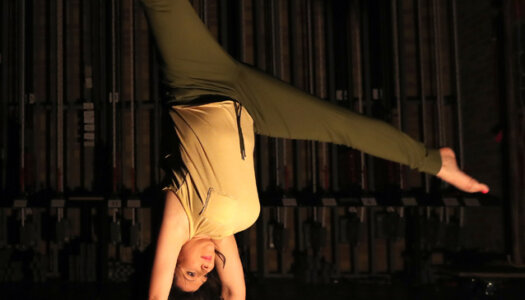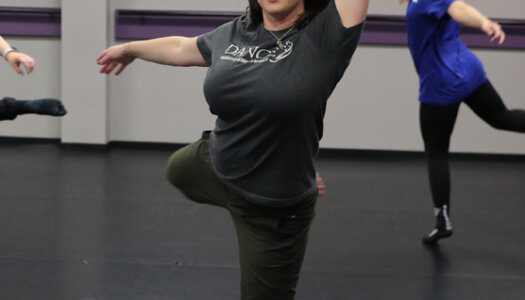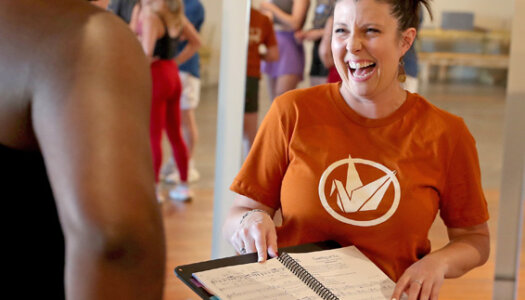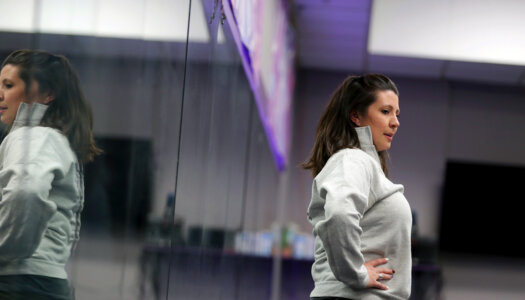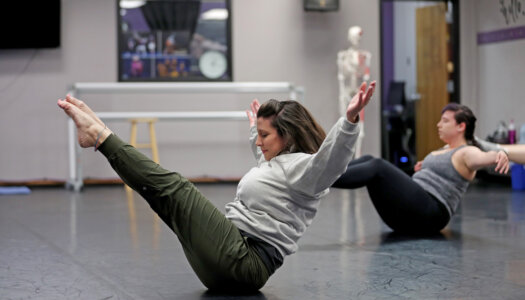
VIEW THE 2022 NEW FRONTIERS MAGAZINE FEATURING BOHATY AND OTHER UNK FACULTY
KEARNEY – Students are the heart of Noelle Bohaty’s work at the University of Nebraska at Kearney.
“They are the vessels and collaborators that bring movement to life,” she says.
As director of the UNK Dance Program, Bohaty fosters an environment of connection, communication, creativity and empowerment.
Her studio is far more than a rehearsal space. It’s a home for movers, dreamers, explorers and adventurers – a place that pulses with rhythm and energy as students experience the exhilaration of the creative process.
“My classroom is a safe space for students to take risks, because we operate as a community where peer learning is encouraged through partnering, discussion and open dialogue. We know each other’s names. We work together to create a student-centered atmosphere that does not sacrifice artistry or skill building for the sake of comfort. Rather, I reward hard work and effort with patience and encouragement. I aim for each course to be a conversation, a guided investigation between teacher and students.”

How do you approach dance instruction/research?
From a choreographer’s standpoint, I approach dance from both within the piece as a performer and outside the piece as a viewer. Both process and product are equally important to me, as an educator and an artist.
Dance is a language that can be intimidating to understand, though it speaks with a lexicon to which we can all relate: the human body. There is an incredible beauty to movement as research because of this common ground. In fact, there is a section of our brains (mirror neurons) designed to have a kinesthetic response to watching other people move. That innate, kinesthetic empathy is a response that transcends all other art forms. Mirror neurons communicate with the motor cortex for our visual system to experience watching movement as movement.
I teach in order to connect: people, ideas, projects, bodies. I strive to build this connection for my students through rigorous studio practice, as well as verbal and physical articulation. Using these methodologies, I empower students to translate introspection and imagery into motion; coupling the imagination of artists to people and projects, and all these to the stage. As an enthusiastic explorer of movement, space and time – of ideas and beliefs and the in-betweens – I am an artist by nature, a choreographer by craft and an educator at heart. I believe in the value of personal, artistic voice.
How do you involve students in your work?
UNK Dance students have a dual opportunity to work with and create from this place of connect. I bring an arsenal of repertory work from my company at the regional and national levels. I craft new works using UNK students as medium and originators. Students have an opportunity to learn and perform repertory that was first staged at national companies such as BalletMET and regional preprofessional programs, as well as on East Coast MFA and BFA dancers.
Additionally, UNK students had the advantage of being the originators of nine premiere works, including an evening-length culmination of years of research, “at what stakes; the devil you know.” Based on the text compiled from Nancy Goldstone’s “The Maid and The Queen: The Secret History of Joan of Arc,” Madeleine L’Engle and transcripts from the Brock Turner/Stanford and Cory Batey/Vanderbilt assault trials, “at what stakes” examines the life and death of Joan of Arc while troubling contemporary parallels of the spoils of war and the #MeToo movement. Students were involved in the process from the ground up, generating movement material, translating text to and from French, performing as voice-over artists and teaching their peers sections of dance phrases they crafted. They were a pivotal and integrated part of all these processes, and their names will appear in programs at future restagings of this work.
When did you know this would be your profession?
My educational journey reflects my varied interests; I hold degrees in philosophy, neuroscience, psychology, acting, education, directing and dance. I knew I wanted to be involved in the arts before I knew I wanted to be in higher education. The journey to higher ed was almost happenstance. While working as a freelance choreographer and instructor at varying theaters and dance studios, I was invited to apply for a position at the University of Nebraska-Lincoln. After three years of working with the students under the tutelage of my mentor, Susan Levine Ourada, I was inspired to continue my studies and applied to Ohio State University for an MFA in dance with a choreography and performance emphasis. While there, I found a way to continue my studies in theater – directing specifically – and was able to take classes with the MFA acting cohort, eventually earning a graduate minor in directing.

Why were you attracted to this area?
I was first drawn to dance because it was where I was least comfortable. My early training in dance was limited, so it was both fascinating and terrifying to me. That combination kept me coming back as a young artist. I thrived on the challenge. I started taking dance classes to supplement my training in theater and music at the age of 14 – which in the dance field is incredibly late! There are some intensive programs, especially in ballet, where students make professional debuts at that age. Instead of deterring my desire, it only made me work harder with laser focus. It also gave me opportunities to start my choreographic journey at a young age in the dance studio and community theater. Though I didn’t know it at the time, it jump-started my teaching career.
Initially, I worked as an assistant for younger students until getting my own classes to teach. During this time, my first teachers and choreographers had an incredible impact on me: never once was I treated differently because I started later than most. Every single one of them – Stephanie and Bob Chase, Melissa Rosenberger, Jenny Farber, Erynn Nicholson Butzke – always had the attitude that the most important things to my success were grit, willingness to fail and try again, and most importantly putting in the work. There is no substitute for cumulative time in the studio.
When I entered my undergraduate studies at Washington University in St. Louis, I was fortunate to be in a program that welcomed artists from every background and relished in viewing dance from many lenses: neuroscience, architecture, psychology, kinesiology. This program truly gave me wings to pursue dance as a career because it encouraged thinking holistically about movement. Once that confidence set in, knowing that my personal lens of the field and what I bring to it is important and valuable, I was able to fully explore the field, leading to the realization that I wanted to bring this same physical confidence to my students.
How do you measure success?
Success in the arts is more difficult to measure than in other fields. In dance, there is no script: we start with a blank slate and eloquent, moving, articulate bodies. The choreographic journey is exhilarating in that it is the process of crafting something completely original every single time. What is seen as the product is the result of incalculable hours of training, planning and technical execution. What is felt in the process, however, is love of the work. Love of the challenge of crafting stage pictures and generating movement phrases; love of close collaboration with peers and faculty; love of the bumps, scrapes, bruises, blisters, torn skin and tattered toenails; love for the gift of a moving body; love for the privilege of walking into the studio day after day and being met with enthusiasm and possibility; love of the work of it.
As a movement researcher and arts educator, this is the key aspect of the work that I hope to pass on to the viewer and performer. I always invite the audience to savor the luscious work, but more importantly I invite them to revel in the love. Success is a viewer who doesn’t feel the pressure to have a knowledge of dance training and history or a command of the technical language to experience the sheer joy of the performers sharing their personal preparation, hard work and exceeding amount of love.
I am privileged to witness the resilient lives of my students daily, both in and out of the dance studio. I see it in the way they plie in and plie out of the floor; the way they dance the transitions and honor the moment. I experience it when they follow their dreams and encourage each other when the road seems tough. They overcome, show up and try again and again. Dance training is not an easy road, but they welcome the rigor and hold each other accountable to be the best version of themselves. They hold each other up when life throws them lemons and teach each other what true growth means. They create awe-inspiring, mature choreographic works, and offer themselves as medium to their colleagues, so those works can come into existence – ephemeral though it may be.
PHOTOS BY ERIKA PRITCHARD, UNK COMMUNICATIONS

Title: Associate Professor of Music, Theatre and Dance; Director of Dance
College: Arts and Sciences
Education: Master of Fine Arts in dance with performance/choreography emphasis and graduate minor in theatre, Ohio State University, 2016. Bachelor of Arts in philosophy-neuroscience-psychology and dance with minors in children’s studies and acting, Washington University in St. Louis, 2008.
Years at UNK: Six
Areas of research/specialization: Choreography and Performance, Dance Theatre, Dance Film and Dance Pedagogy.
Courses taught: Dance Appreciation, Modern Dance, Jazz Dance, Tap Dance, Ballet, Dance Composition and Improvisation.
Recent published articles: “In These Walls: A Site-Specific Explorations of Dance and the Audience Experience,” 52 Washington University Undergraduate Research Digest, 2008.
Selected choreographic/directorial work: “And the World Goes ‘Round,” Miriam Drake Theatre, Kearney, 2022; “Reset,” Miriam Drake Theatre, Kearney, 2021; “undercurrent,” Dance Across Nebraska, Museum of Nebraska Art, Kearney, 2021; “Eurydice,” Kennedy Center American College Theatre Festival 51, 2019. “re.solution,” Regional Dance America, 2019; “Rubatosis,” Nebraska in Motion, Orpheum Theatre – Omaha Performing Arts, Omaha, 2017.
Selected performance work: “Horizon Time,” Ohio State University Department of Dance, Columbus, Ohio, 2014: “neither: here nor there,” Miriam Drake Theatre, Kearney, 2018; “Sea of Red,” Lied Center for Performing Arts, Lincoln, 2019.

